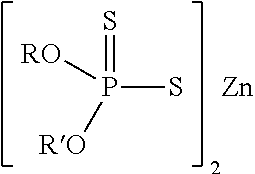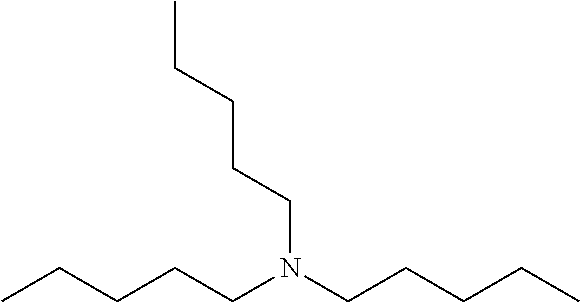Lubricating Oil Compositions Containing Sterically Hindered Amines as Ashless TBN Sourcces
a technology of amines and lubricating oil, which is applied in the direction of foam dispersion/prevention, liquid degasification, separation processes, etc., can solve the problems of oxidation catalysts that can become poisoned, render less effective, claim that such lubricants will provide sufficient tbn, etc., and achieve the effect of increasing the tbn of lubricating oil compositions and reducing the content of sash
- Summary
- Abstract
- Description
- Claims
- Application Information
AI Technical Summary
Benefits of technology
Problems solved by technology
Method used
Image
Examples
synthesis examples
Amine 1: Linear Amine—Tri-n-Pentylamine (Comparative)
[0072]
[0073]Commercially available material; available from Tokyo Chemical Industry, Tokyo, Japan and TCI America, Portland Oreg., USA at 98% purity.
Amine 2: Linear Amine—Tri-n-Octylamine (Comparative)
[0074]
[0075]Commercially available material; available from Alfa Aesar, A Johnson Matthey Company, Ward Hill, Mass., USA at 95% purity.
synthesis example 1
Amine 3: Tris(2-Ethylhexylamine)
[0076]
[0077]Bis(2-ethylhexyl)amine (30 g, 124 mmol), 2-ethylhexanal (23.9 g, 186 mmol), and dichloromethane (DCM, 50 g) were stirred at room temperature in a 250 mL 4-neck round bottom flask equipped with a reflux condenser, thermocouple, overhead stirrer, and nitrogen blanket for 5.5 hours. Sodium triacetoxyborohydride (STAB, 31.6 g, 149 mmol) was slowly added portion-wise to the flask (caution: exotherm). An ice bath was used to reduce the temperature and control the exotherm, as needed. The reaction mixture was left to stir 48 hours. 1H NMR showed the reaction reached completion and was quenched with saturated aqueous sodium bicarbonate solution (caution: effervescence). The organic layer was washed with saturated aqueous sodium bicarbonate and brine. This layer was then dried over magnesium sulphate, filtered, and concentrated yielding clear oil. Product was purified by column chromatography [heptane / ethyl acetate 90 / 10] (31.8 g, 72.4% yield). GC-...
synthesis example 2
Amine 4: 2-Ethyl-N,N-bis(2-ethylbutyl)hexan-1-amine
[0078]
[0079]2-ethylhexan-1-amine (15 g, 116 mmol), 2-ethylbutanal (25.6 g, 255 mmol), and DCM (50 g) were stirred at room temperature in a 250 mL 4-neck round bottom flask equipped with a reflux condenser, thermocouple, overhead stirrer, and nitrogen blanket for 6 hours. Sodium triacetoxyborohydride (STAB, 54.1 g, 255 mmol) was slowly added portion wise to the flask (caution: exotherm). An ice bath was used to reduce the temperature and control the exotherm, as needed. The reaction mixture was left to stir for 12 hours. 1H NMR showed the reaction reached completion and was quenched with saturated aqueous sodium bicarbonate solution (caution: effervescence). The organic layer was washed with saturated aqueous sodium bicarbonate and brine. This layer was then dried over magnesium sulphate, filtered, and concentrated yielding a clear oil. Product was purified by column chromatography [hexanes / ethyl acetate 90 / 10] yielding an 88% pure p...
PUM
| Property | Measurement | Unit |
|---|---|---|
| mass % | aaaaa | aaaaa |
| mass % | aaaaa | aaaaa |
| mass % | aaaaa | aaaaa |
Abstract
Description
Claims
Application Information
 Login to View More
Login to View More - R&D
- Intellectual Property
- Life Sciences
- Materials
- Tech Scout
- Unparalleled Data Quality
- Higher Quality Content
- 60% Fewer Hallucinations
Browse by: Latest US Patents, China's latest patents, Technical Efficacy Thesaurus, Application Domain, Technology Topic, Popular Technical Reports.
© 2025 PatSnap. All rights reserved.Legal|Privacy policy|Modern Slavery Act Transparency Statement|Sitemap|About US| Contact US: help@patsnap.com



